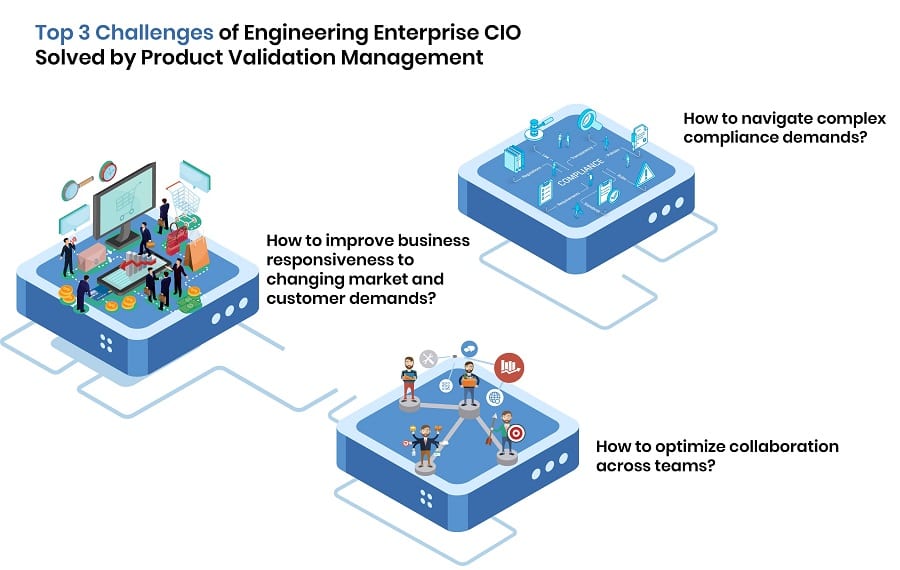How Product Validation Management Solves the Top 3 Challenges of Engineering Enterprise CIO
The focus on technology and digital transformation has increased phenomenally in the engineering space. The evolving nature of engineering products, such as automobiles, develops the need to respond to market conditions faster. The capacity to improve decision-making capabilities to enhance innovation and meet regulatory and compliance norms are emerging as key strategic priorities in this sector.
Engineering organizations are also looking to improve their business agility and respond effectively to market conditions. The role of the CIO in engineering companies is, as such, evolving and becoming that of a change instigator and business enabler.
As automation and digital transformation become resonating themes across engineering companies as enablers of good business outcomes, the CIOs in engineering companies are facing an inflection point defined by the challenges to growth and opportunities to improve quality.
Product Validation Management solves many of these problems for CIOs of engineering companies. It allows them to accelerate development and testing velocity and innovation, increase accuracy and reliability, and respond to market conditions faster.
Here is a look at how.
What Is Product Validation Management?
Product Validation Management (PVM) is an approach that employs verification and validation of requirement analysis, function design, and software development in the engineering process. This model is heavily focused on testing and iterative development and allows organizations to easily manage deadlines and costs.
In engineering companies such as those operating in the EV space, the product development stage consists of simulation, validation, and physical testing. PVM refines the design and development process and helps engineering companies fix any unforeseen problems.
From design suitability to real-world interactions, PVM ensures that products will survive the environmental conditions to which they will be exposed. It additionally delivers the agility to respond to evolving market and customer demands with equal ease.

How Is PVM the CIOs Best Mate?
Since digitization initiatives and technology implementations are essential for driving good business outcomes for engineering companies, the role of the CIO assumes strategic importance. As engineering companies come out of the economic downturn brought upon by the pandemic, the three major challenges and simultaneously key priorities for CIOs to navigate are to:
Improve Business Responsiveness to Changing Market and Customer Demands
When it comes to engineering product development, accelerating the development and testing speed becomes crucial for faster time-to-market and increased business responsiveness. While physical prototyping and testing cannot be ignored, it is vital to minimize actual machine tests and improve the efficiency of the overall development process.
PVM creates a foundation that allows engineering enterprises to create a sustainable environment that allows model-based development. It also enables engineering enterprises to transform the classical validation process into data-driven engineering and build efficient systems in less time.
With a solid, scalable foundation in place, enterprises can employ MBD (Model-Based Development), as well as AI/ML-enabled physical model characterization and real-time plant simulations for control validations.
PVM supports interfaces needed to test critical components for field scenario simulation inside the rigs, such as environment simulators, battery simulators, etc. They can generate scenarios throughout the validation life cycle and conduct reliable UUT testing from the element level to the vehicle level.
Engineers can also verify design matrix combinations and validate functions like range estimation, the durability of the components, etc., faster. These efficiencies and capabilities improve the time-to-market and business responsiveness.
Optimize Collaboration Across Teams
Faster time to market and greater responsiveness to market demands is only possible when different teams and stakeholders in the engineering ecosystem can collaborate seamlessly. However, data and knowledge silos impede collaboration and, as such, impact the enterprises’ capability to drive innovation at speed.
PVM helps organizations drive collaboration across teams by creating a single source of truth. A centralized data repository ensures that all data, be it from physical testing or simulations across different departments, is contained in one place for all to access and employ. It also facilitates the seamless exchange of engineering data across the validation process across teams and multi-locations globally.
A cloud-based PVM infrastructure can be accessed by multi locations globally and facilitates inter-domain data exchange. This access to data increases the capacity of teams to work collaboratively, reduces the repetition of work and manual efforts, and increases productivity. All the data in one place gives the stakeholders, such as the engineers, simulators, maintenance engineers, testbed operators, design architects, etc., greater confidence.
Engineering organizations can take an integrated approach to product development using PVM. It refines the entire process and creates an ecosystem that stores data from every lifecycle stage and ensures better, faster, and more reliable decisions while facilitating cross-functional communication.
Navigate Complex Compliance Demands
As the compliance landscape increases in complexity, it becomes essential to not only create a single source of truth but also ensure that the data can be tracked all the way down.
PVM allows organizations to create an engineering meta-data dictionary. This dictionary contains the measurement data along with the experiment conditions & characteristics. This approach standardizes entire engineering processes and their language across the organization.
PVM helps organizations store engineering data from the validation area with clear and precise descriptions versus the measurement point and engineering data types (such as crank angle-based, time series, frequency type, and ECU data). It also details the conditions under which data is measured.
Since the PVM allows organizations to create a single source of truth across teams, departments, third parties, and other stakeholders, audits are a breeze.
In Conclusion
CIOs are now the pilots of engineering companies as they transform digitally. The right technology solutions deliver immense capacity to innovate, eliminate wasteful processes, increase test reliability, and enable data-driven decisions. A scalable and flexible cloud-based PVM infrastructure becomes a conduit that allows engineering enterprises to create a sustainable ecosystem designed for innovation.



